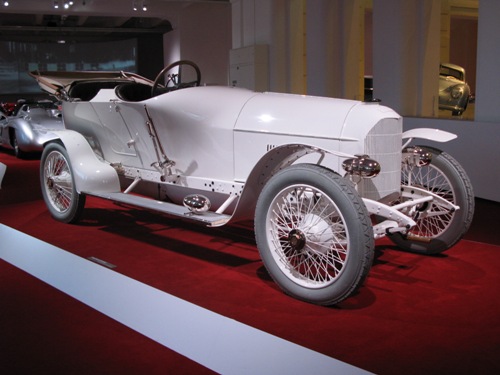
Austro-Daimler 28/32 HP
Coupé-Chauffeur
1908
In 1906, prospects for the Wiener Neustadt automobile manufacturer were good. Emil Jellinek-Mercedes, who had already turned the May-bach automobile of 1900 into a bestseller as the Mercedes Simplex and made himself wealthy in the process, gained a huge influence on the "Österreichische Daimler Motoren Gesellschaft" as a major shareholder. The newly appointed chief engineer, Ferdinand Porsche, was commissioned to come up with a new successful model in a short space of time, to save the Austrian branch of the German Daimler Group from paying expensive license fees. The Mercedes effect did not happen. The Maya project failed, due on the one hand to technical inadequacies and, on the other, to a generally deflated mood in the automobile market.
With the design revised, interest in the new Austro Daimler 28/32 HP from a member of the imperial household proved most fortuitous: Archduke Leopold Salvator, Artillery Inspector General for the Royal and Imperial Army and a champion of military motorization, made regular use of this automobile and time and again had it fitted out with the very latest equipment. Perhaps it was its grade ability of 22 per cent which fascinated the high-ranking military man; in any case, the "Österreichische Motoren-Aktiengesellschaft", the official name adopted by the works as of 1910, received significant development contracts from the Army. After the two World Wars, the Austro Daimler 28/32 HP was owned by a British collector for half a century before it was acquired by a descendant of Ferdinand Porsche in 1996.

Austro Daimler
Prinz Heinrich Wagen
1910
"Victory [is] possible only if you build […] a refined car, so to speak. Well, that's not a problem for me, as I shall prove in 1910." said Ferdinand Porsche after competing in the Prince Heinrich Tour of 1909. At the second endurance and reliability test initiated by the German Emperor's younger brother, a test which turned into nothing short of genuie race, Porsche scored a succès d’estime driving a further development of the Maya car made by the "Oesterreichische Daimler Motoren Gesellschaft", and finished without a single penalty point. In a bid to enter a car that was not only reliable but also fast in the third and final race, Porsche and his design team developed a completely new, sophisticated car in only a year. For the design of the chassis and body, the team worked with Igo Etrich, the Austrian aviation pioneer. Term such as fish shape, tulip cross-section, and wasp tail indicate how early aerodynamic findings were implemented into the creation of an exceptionally slipstreamed car whose engine, with its four individual cylinders and overhead camshaft, propelled to top speeds of 140 km/h.
On the evening of 10 June 1910, after eight days of racing, a total distance of almost 2,000 km and 17 special stages, Austro-Daimler's triumph was complete. The Austro-Daimler team had prevailed against 173 international competitors with a triple victory. The winner's cup was a 13.5 kg car sculpture made of pure silver.

Rolls-Royce Silver Ghost
1913
"The quality is remembered long after the price is forgotten." There is not much to add to this sales argument by Frederick Henry Royce. With its mix of shrews market strategies, high-quality craftsmanship, and the best of British mechanical engineering, Rolls-Royce Ltd. Has excelled, right from the dawn of the automobile age, at attracting a wealthier clientele. The company’s early sales success was established with the presentation in 1906 of the Silver Ghost, which first came off the assembly line in 1907. In the US in the 1920s, the distinguised Brit prove hugely popular, prompting the company management to open up another factory in Massachusetts to produce Silver Ghosts made in USA. Over a period of just under two decades, the Silver Ghost would be manufactured 7,876 times with only minor variations, with 1,703 made in the US. The "best car in the world" owed its name to its ghost-like quietness, which was in turn the result of its six-cylinder engine, split into two three-cylinder units on a common crankcase. With typical understatement, the engine's official power output was to be sufficient.
This Silver Ghost from 1913 was owned by members of Barbour clothing dynasty for many decades. While it originated from the Rolls-Royce factory in Derby, it also traveled on roads the other side of the Atlantic for several decades after a branch of the Babour family had emigrated to Florida.
